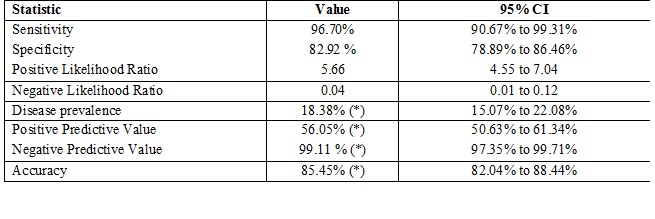A study to evaluate HbA1C as an independent diagnostic criterion comparing to fasting plasma glucose and postprandial glucose levels as a standard test for diagnosis of diabetes
Abstract
Aims and objectives: 1) To compare and correlate glycosylated haemoglobin (HbA1C) as an independent criteria in diagnosis. 2) To define the sensitivity and specificity of HbA1C estimates at the ADA recommended cut off of ≥ 6.5%.
Study design and methods: Subjects were first tested for Fasting plasma glucose and two-hours post 75 grams glucose challenge, HbA1c was estimated for the all the subjects.
Results: The sensitivity and specificity of HbA1C at the ADA recommended ≥ 6.5% cut off value in newly detected diabetic patients was 96.70% and 82.92%respectively with a positive predicted value of 56.05% and a negative predictive value of99.11 % .75.00 % at a p<0.001.We find that we miss 42% of people with diabetes if fasting plasma glucose levels are considered. Given the risks associated with PPG levels in our population it is important that these criteria be used in screening programmes.
Conclusion: Our study shows that HbA1C is comparable to FPG levels estimation but is not superior enough to replace blood glucose estimation. Use of post prandial glucose levels are better in detecting diabetes than fasting plasma glucose levels. A combination of post prandial glucose with HbA1C may be a superior single test that can overcome the cumbersome oral glucose tolerance test.
Downloads
References
International Diabetes Federation. IDF Diabetes Atlas, 8th edn. Brussels, Belgium: International Diabetes Federation, 2017.
American Diabetes Association. 2. Classification and Diagnosis of Diabetes: Standards of Medical Care in Diabetes-2018. Diabetes Care. 2018 Jan;41(Suppl 1):S13-S27. doi: https://doi.org/10.2337/dc18-S002.
Adepoyibi T, Weigl B, Greb H, Neogi T, McGuire H. New screening technologies for type 2 diabetes mellitus appropriate for use in tuberculosis patients. Public Health Action. 2013 Nov 4;3(1):10-7.
International Expert Committee. International Expert Committee report on the role of the A1C assay in the diagnosis of diabetes. Diabetes Care. 2009 Jul;32(7):1327-34. doi: https://doi.org/10.2337/dc09-9033. Epub 2009 Jun 5.
American Diabetes Association. 2. Classification and Diagnosis of Diabetes: Standards of Medical Care in Diabetes-2018. Diabetes Care. 2018 Jan;41(Suppl 1):S13-S27. doi: 10.2337/dc18-S002.
World Health Organization. Definition and diagnosis of diabetes mellitus and intermediate hyperglycaemia: report of a WHO/IDF consultation. 2006 IDF Consultation. Geneva, World Health Org., 2006
Gallagher EJ, Le Roith D, Bloomgarden Z. Review of hemoglobin A(1c) in the management of diabetes. J Diabetes. 2009 Mar;1(1):9-17. doi: https://doi.org/10.1111/j.1753-0407.2009.00009.x. Epub 2009 Jan 27.
Ziemer DC, Kolm P, Weintraub WS, et al. Glucose-independent, black-white differences in hemoglobin A1c levels: a cross-sectional analysis of 2 studies. Ann Intern Med. 2010 Jun 15;152(12):770-7. doi: https://doi.org/10.7326/0003-4819-152-12-201006150-00004.
Kumar PR, Bhansali A, Ravikiran M, et al. Utility of glycated hemoglobin in diagnosing type 2 diabetes mellitus: a community-based study. J Clin Endocrinol Metab. 2010 Jun;95(6):2832-5. doi: https://doi.org/10.1210/jc.2009-2433. Epub 2010 Apr 6.
Bonora E, Tuomilehto J. The pros and cons of diagnosing diabetes with A1C. Diabetes Care. 2011 May;34 Suppl 2:S184-90. doi: https://doi.org/10.2337/dc11-s216.
Mohanty D, Colah RB, Gorakshakar AC, et al. Prevalence of β-thalassemia and other haemoglobinopathies in six cities in India: a multicentre study. J Community Genet. 2013 Jan;4(1):33-42. doi: https://doi.org/10.1007/s12687-012-0114-0. Epub 2012 Oct 21.
Cowie CC, Rust KF, Byrd-Holt DD, et al. Prevalence of diabetes and high risk for diabetes using A1C criteria in the U.S. population in 1988-2006. Diabetes Care. 2010 Mar;33(3):562-8. doi: https://doi.org/10.2337/dc09-1524. Epub 2010 Jan 12.
Wang W, Lee ET, Howard BV, et al. Fasting plasma glucose and hemoglobin A1c in identifying and predicting diabetes: the strong heart study. Diabetes Care. 2011 Feb;34(2):363-8. doi: https://doi.org/10.2337/dc10-1680.
Yun WJ, Shin MH, Kweon SS, Park KS, Lee YH, Nam HS, Jeong SK, Yun YW, Choi JS. A comparison of fasting glucose and HbA1c for the diagnosis of diabetes mellitus among Korean adults. Journal of preventive medicine and public health. 2010 Sep;43(5):451-4.
van 't Riet E, Alssema M, Rijkelijkhuizen JM, et al. Relationship between A1C and glucose levels in the general Dutch population: the new Hoorn study. Diabetes Care. 2010 Jan;33(1):61-6. doi: https://doi.org/10.2337/dc09-0677. Epub 2009 Oct 6.
Rohlfing CL, Wiedmeyer HM, Little RR, et al. Defining the relationship between plasma glucose and HbA(1c): analysis of glucose profiles and HbA(1c) in the Diabetes Control and Complications Trial. Diabetes Care. 2002 Feb;25(2):275-8.
Kavya S. T, Nagaraja B. S, Akila V, G. Chandra Mohan, Prakash KikkerGowdaiah. Comparative Study of Glycosylated Haemoglobin with Blood Glucose Levels in the Diagnosis of Diabetes Mellitus. Journal of Evolution of Medical and Dental Sciences 2014; Vol. 3, Issue 23, June 09; Page: 6435-6443, DOI: https://doi.org/10.14260/jemds/2014/2760



 OAI - Open Archives Initiative
OAI - Open Archives Initiative


